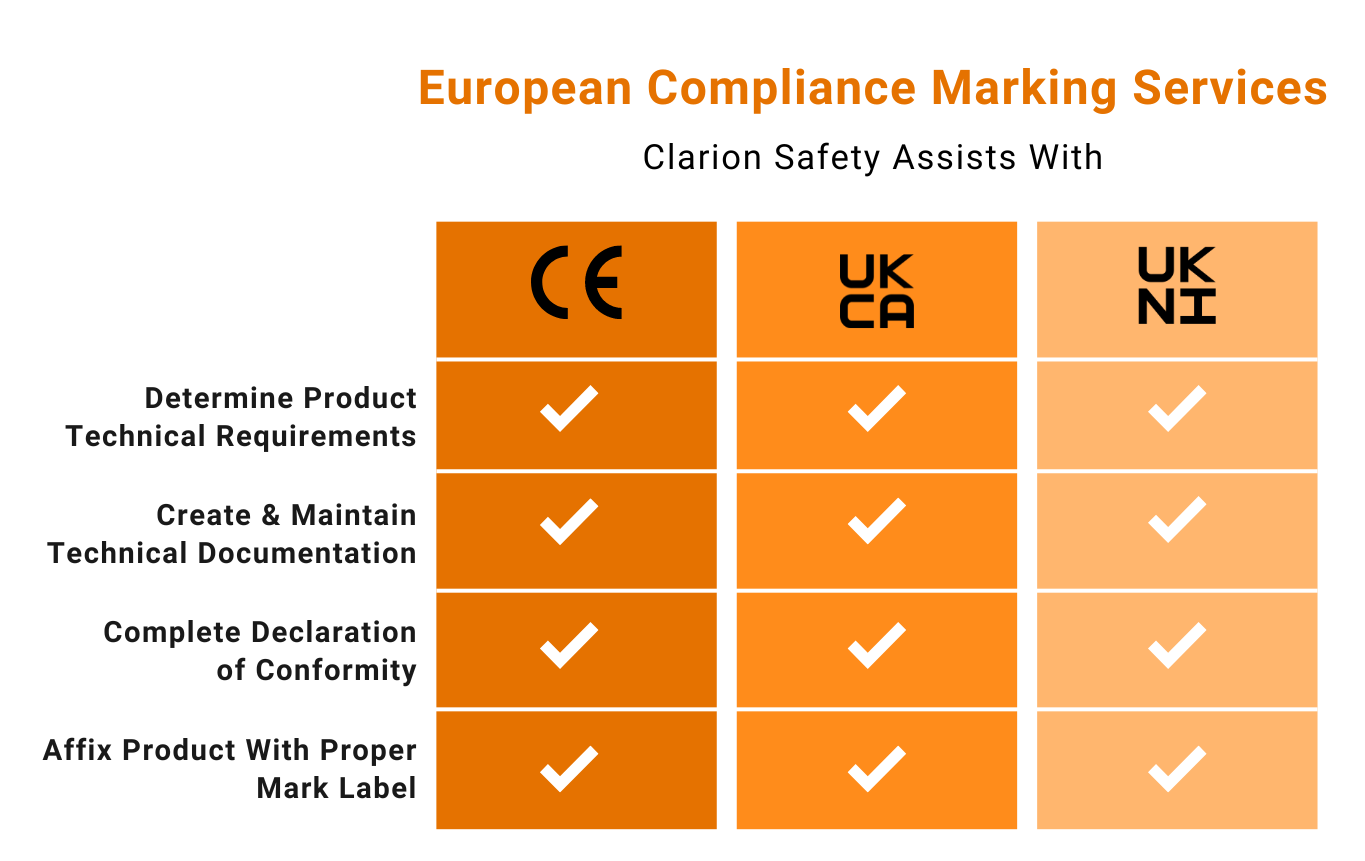European Mark Compliance
In addition to designing machinery and equipment to be as safe as possible for end users, today’s manufacturers must also ensure regulatory markings are required on products being shipped into and out of certain countries to comply with various national and international product labeling regulations.
Failure to label a product with required markings could result in it being permanently shelved in addition to costly fines and penalties. Before Brexit, the United Kingdom and European Union both utilized the CE mark, although once the separation happened, two more marks developed, resulting in UKCA, UKNI, and CE markings being needed across markets for products.

CE Marking Compliance
Within European Union (EU) member states, or for trading in the European Economic Area (EEA) and European Free Trade Association (EFTA) countries, most products are mandated to have a Conformité Européenne (CE) mark present.
Why the CE Mark is Needed
The letters “CE” appear on products produced and distributed in Europe. The CE marking, a requirement based on EU directives for products, is a declaration by the manufacturer that its product complies with the relevant, legal European requirements. It signifies that the product has been assessed to meet high safety requirements – which has benefits for both businesses and consumers. By showing the CE mark, businesses know that the product can be traded in the EU, EEA and EFTA, and consumers are guaranteed a level of safety throughout those areas. Because only one mark is required to show CE compliance in over 30 countries, it simplifies factors for machine builders and distributors.
CE Marking Requirements for Manufacturers
Manufacturers are responsible for verifying that their products meet EU requirements for safety, health, and the environment. They must carry out the conformity assessment, maintain technical files, complete an EU Declaration of Conformity and affix the CE mark to their product. The procedure varies by product but generally includes these six steps:
- Identifying applicable directive(s) and harmonized standards
- Verifying product-specific requirements
- Identifying whether an independent conformity assessment by a notified body is necessary
- Testing the product to check its conformity
- Compiling and keeping available required technical documentation
- Affixing the CE marking and completing an EU Declaration of Conformity, which must include:
- The manufacturer's name, trademark and contact information
- A list of the directives and standards used in the assessment of the product, and
- Information on any notified body involved in the product's conformity assessment.
Our CE Mark Consulting Services
Navigating the CE marking process doesn’t have to be painstaking, which is why we offer CE marking services to help you ensure that you’re meeting necessary requirements and are in compliance.
UKCA Marking Compliance
The United Kingdom Conformity Assessed (UKCA) mark is the result of the United Kingdom’s (UK) official exit from the European Union. This also included a separation from the single market, where the CE mark is the universally accepted regulatory marking. While in most cases the CE mark can still be used for the UK market during a transition period up until January 1, 2025, the UKCA mark will replace the CE mark at the end of the transition. This means that the UKCA mark must be visibly applied to UK market products that require conformity to relevant UK legislation in order to be in compliance.
Using the UKCA Mark
UKCA marking, in most cases, must be applied directly to the product in a visible location. If this is not possible, the mark should then be applied to any of the product’s packaging and relevant documents. Exact requirements will vary depending on the product and the regulations that apply it.
However, some general guidelines to follow are:
- Only manufacturers – or authorized representatives where legislation allows – are able to apply UKCA markings to a product.
- The manufacturer takes full responsibility for relevant legislation conformity when applying the UKCA mark.
- The UKCA mark must only be used to show conformity with UK legislation.
- Do not apply visuals that affect the visibility, legibility, or meaning of the UKCA mark.
- Do not apply any other marking or sign which confuses the meaning or form of the UKCA mark.
- Do not use the UKCA mark on a product unless there is a specific requirement to do so by legislation.
Changes to UKCA That Manufacturers Should be Aware Of
The new UK regulations do not change product safety and other compliance standards, which are still required and to be applied as normal. However, there are changes to procedure which manufacturers should be aware of. First, EU-based businesses that bring UK products into the EU are now classified as “importers” instead of “distributors”. This is not just a title change, as importers must include a technical file and indicate their business name and address on their product, in addition to the previously required declarations, instructions, and markings.
Second, importers of products marketed in the UK must be established in the UK. Product labeling requirements can be met by including the specified information on the product’s accompanying documents for a period of 18 months. Authorized representatives already established in the EEA will continue to be recognized by the UK. Any established after December 31, 2020, must be established in the UK.
Our UKCA Mark Consulting Services
Times of transition for regulatory compliance can be difficult and complex, which makes an expert opinion all the more valuable. This is why we offer UKCA marking services to help you ensure that you’re meeting necessary requirements and are in compliance when the transition period ends as of January 1, 2025.
UKNI Marking Compliance
The United Kingdom Northern Ireland (UKNI) mark is a new conformity marking for products and manufactured goods placed on the market in Northern Ireland. The Northern Ireland Protocol brought the UKNI mark into effect on January 1, 2021, aligning Northern Ireland with relevant EU rules for placing manufactured goods on the market. To show that your products meet the rules, manufacturers must apply the UKNI marking and place products through the mandatory third-party conformity assessment.
Using the UKCA Mark
Northern Ireland continues to use EU conformity markings to show goods that meet EU standards. The majority of these goods will still use the CE mark, but other markings may be required for certain products, such as the UKNI.
You must use UKNI marking if all of the following apply:
- You are placing certain goods (goods subject to CE marking) on the Northern Ireland market
- Your goods require mandatory third-party conformity assessments
- You plan to use a UK body to carry out that conformity assessment
You should not use the UKNI marking if either of the following apply:
- You are placing goods on the EU market
- You plan on using an EU body to carry out the conformity assessment
UKNI Marking Requirements
Make sure to follow proper procedures when applying the UKNI mark. It’s important to remember that you’re taking personal responsibility for your product’s conformity when you attach the mark. This general set of rules should be kept in mind when using the UKNI mark:
- Only the product manufacturer or authorized representative may place the UKNI marking on a product
- Do not use any other marking or sign that may confuse the meaning or form of the UKNI marking to third parties
- Do not attach any other markings on your product which affect the visibility, legibility, or meaning of the UKNI marking
- Do not apply the UKNI marking to your product unless it is specifically required by the legislation
- The UKNI marking must always accompany another conformity marking; it never appears on a product alone
Our UKNI Mark Consulting Services
Our knowledgeable compliance team can assist you in navigating these new regulatory compliance requirements in Northern Ireland and the EU. This is why our safety solutions include UKNI marking services to help you ensure that you’re meeting necessary requirements and are in compliance.
